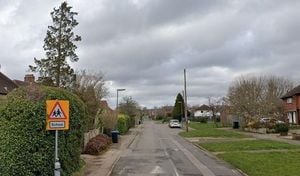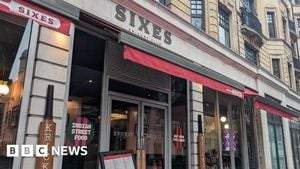On a blustery October day in Chesterfield, Derbyshire, a colossal 100ft (30m) Union Jack flag appeared on the side of a former council building, catching the attention of locals and passersby alike. The man behind this bold display, property developer James Holmes, 51, had more than just patriotism in mind—he was determined to stand his ground after months of disputes with the local authority.
The saga began back in September 2025, when Holmes installed a 36ft (11m) Union Jack on the old North East Derbyshire District Council building in Saltergate, Chesterfield. According to the BBC, the flag bore a “Fly the Flag” slogan and a QR code linking to Holmes’s campaign website. However, Chesterfield Borough Council quickly intervened, labeling the banner an “unauthorised advertisement” due to its commercial nature. The council stated it would take enforcement action unless Holmes removed the offending advertisement.
Undeterred by the official warnings, Holmes remained resolute. “This flag was a mistake—I should have made it bigger,” he quipped to the BBC. “I could have had it two metres bigger really, [and it would] still fit on that part of the building. I might order another one now for the other half of the building as well.” Yet fate intervened before Holmes could act on his ambitions. Storm Amy swept through Derbyshire in early October, tearing the original flag to shreds and leaving Holmes with a blank canvas—and a renewed sense of purpose.
Instead of backing down, Holmes doubled down. He spent £2,500 (some reports say £3,000) on a new, even larger 100ft banner, this time omitting any branding, slogans, or QR codes. As reported by the Manchester Evening News, the new flag was pure, unadorned patriotism. Holmes, who has invested a total of £15,000 in flags for this site and other properties, explained his motivation: “I never even saw it as being controversial, just encouraging people to fly the flag from the country they're from. I don't care, I'm prepared to stand up and see our flag fly like they do in other countries.”
The council, led by Labour, had previously opposed Holmes’s displays, but this time, the situation changed. In a surprising about-face, Chesterfield Borough Council conceded that the new flag did not breach any planning laws. A spokesperson for the authority told the BBC, “It’s evident that Mr Holmes is keen to recognise our national period of Remembrance, which is something we also value highly as a council.” The official added, “The large Union Flag currently displayed does not breach any planning laws, so no enforcement action will be taken.”
This resolution followed months of tension and public debate. Holmes, relieved but still frustrated by the drawn-out process, remarked to the Manchester Evening News, “I wouldn’t have taken the flag down anyway but at least the council have seen some sense. It shouldn’t have got to this stage in the first place.” He didn’t mince words regarding the council’s handling of the affair: “It demonstrates how they’re wasting council taxpayers’ money. They work from home and don’t know anything, they’re useless.”
The council, meanwhile, sought to highlight its own commitment to national remembrance. In addition to allowing Holmes’s flag to remain, officials announced plans to install a red poppy cascade on the Town Hall in time for Remembrance Day in November 2025. As a council spokesperson put it, “We also value highly our national period of Remembrance.”
The dispute over the flag was not just about local planning rules or advertising regulations—it tapped into broader questions about national identity, free expression, and the role of public symbols. Holmes’s campaign, “Fly the Flag,” was meant to encourage people to celebrate their heritage, but it struck a nerve in a country where debates over patriotism and national symbols can quickly become contentious. “The reason we’ve got problems in this country is that they’re shaming people to keep their mouths shut,” Holmes said. “I don’t care, I’m prepared to stand up and see our flag fly like they do in other countries.”
The Union Jack itself is steeped in history and symbolism. Its design dates back to 1800, when it was created to mark the union of the Kingdom of Great Britain and the Kingdom of Ireland, forming the first United Kingdom. The flag combines the red cross of St George (England’s patron saint), the red saltire of St Patrick (Ireland’s patron saint), and the saltire of St Andrew (Scotland’s patron saint). Notably, Wales is not represented in the design—a detail that has sparked its own share of controversy over the years.
For Holmes, the flag was never meant to be a lightning rod. “It was never meant to be controversial but clearly, other than the crooked spire, Chesterfield right at this moment is more famous for this flag,” he told the BBC. Yet the story quickly became about more than just one man’s banner. It raised questions about the limits of local government authority, the power of individual protest, and the enduring resonance of national symbols in the public square.
The council’s reversal, described by some as a “U-turn” and by others as a “backtracking,” was welcomed by Holmes but also left him with lingering doubts about the process. “It shouldn’t have got to this stage in the first place,” he repeated, echoing the frustrations of many who see bureaucracy as an obstacle to common sense. Still, the outcome was clear: the 100ft Union Jack would remain, fluttering in the Derbyshire breeze as a testament to one man’s determination and a community’s complex relationship with its symbols.
Looking ahead, the council and Holmes continue to discuss the long-term future of the former North East Derbyshire District Council building. The council confirmed it is engaged in “ongoing discussions” with Holmes about his “long-standing development plans” for the property—a reminder that, even after the flags and the headlines, the business of local governance goes on.
As Chesterfield prepares for Remembrance Day, with its new poppy cascade and the now-iconic flag, the town finds itself at the intersection of tradition, controversy, and community pride. For better or worse, the giant Union Jack has become a symbol not just of national identity, but of the spirited debates that define public life in modern Britain.





